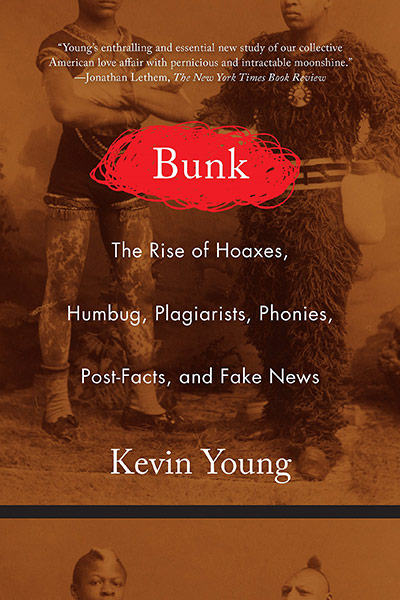REVIEWS BY MICHELLE E. AINSWORTH
In 1980, Alan Abel hoaxed the New York Times into prematurely reporting his death. Thus, in September 2018, his obituary in the same newspaper carried the unusual heading “Alan Abel is (really) Dead.” The contrast of that prank to the President of the United States calling climate change a “hoax” exemplifies the breadth of what can be meant by the word, and makes the concept and consequences of hoaxes worthy of renewed study. Two new books examine the history of hoaxes from different intellectual perspectives. In Bunk, poet Kevin Young uses primary sources to analyze the history of hoaxes, with an emphasis on racial issues and recent fabricated writings. In contrast, the much shorter book Hoax, coauthored by an anthropologist and a science writer, uses secondary sources and full-page photographs to introduce hoaxes of all types, times, and places.
Bunk opens by discussing the racism of the early “humbugs” of iconic 19th century U.S. entrepreneur P.T. Barnum, including the slave he claimed was 161 years old, and the African American man Barnum eventually advertised as a missing link in the then new Darwinian evolutionary theory. I found it exciting that Young explicitly linked the popularity of these exhibits to the rise of scientific racism, discussing the work of eminent mid-19th century natural scientist Louis Agassiz and skull measuring anthropologist Samuel G. Morton. (Skeptic readers will appreciate that Young relies on the analysis of late 20th century skeptic Stephen Jay Gould’s Mismeasure of Man, noting that part of the problem was what we would now call confirmation bias. After his death Gould was himself accused of mismeasuring Morton’s data in a widely discussed article, but subsequent analyses vindicated Gould. Too bad he isn’t still around to join in the debate.) Science appears elsewhere in Bunk too: the séance craze piggybacking on science is mentioned, the hysteria theories of Charcot are discussed, and Oliver Sacks work on the fallibility of memory is noted.

Young’s real contribution, though, is in offering a racial interpretation of hoaxes not so obviously about race. Three examples are his analysis of the 1835 claim by the newspaper the New York Sun of life on the moon (falsely citing real astronomer Sir John Herschel), the late 19th century popularity of spiritualist seances, and the 1917 Cottingley fairy photograph hoax by two girls. Young argues that in each of these hoaxes, the fantastic beings inhabited an imaginary world that was tellingly similar to the real one.
The Cottingley fairy discussion includes the memorable line that for people of the time it was a “comfort to know fairies fluttered among them in a world changing at the newly discovered speed of light.” Young’s discussion of the Cottingley fairy hoax also exemplifies the thoroughness of his research, as he notes three points missing from most accounts: fairy proponent Arthur Conan Doyle’s father’s priorfondness for painting fairies, skeptic James Randi’s discovery of the source illustrations used to create the hoax fairies, and the late 20thcentury confession of one of the hoax’s perpetrators. […]

